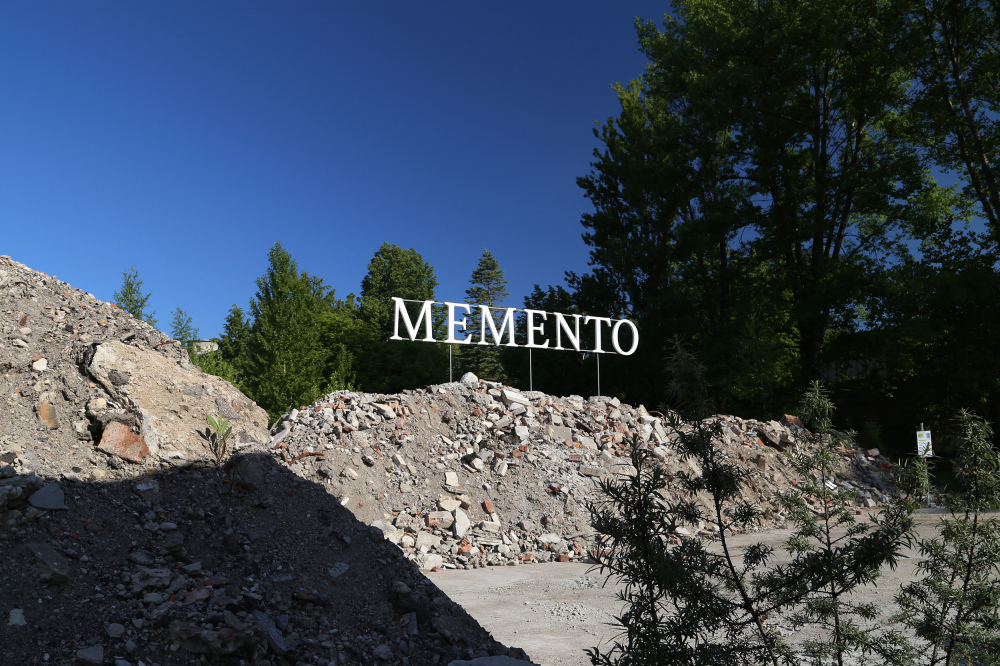-
MEMENTO
Mobilais Muzejs. Nākamā sezona / Mobile Museum. The Next Season
Bijušās tekstilfabrikas „Boļševička” teritorija
03 / 06 - 29 / 08 / 2021
-
[EN]
Art historian Santa Hirša wrote the following for the quadrennial catalogue: “In combining the natural scenography of the city – an abandoned Old Rīga house on the verge of collapse – Krista and Reinis Dzudzilo interpret the classical motif of memento mori with the Latin proverb ‘Respice post te. Hominem te memento’ (meaning “Look behind you, remember that you are human.”). It’s a gesture reminding one of the changing nature of everything that lives, as well as of death’s everlasting presence in all things.”
Slaves in Ancient Rome were obliged to whisper these words in a general’s ear upon his return from a successful campaign, so that the general would be reminded of their presence while basking in the adoration of the crowd. The authors say that the location of this work, Kungu Street [literally, ‘street of the lords’ – translator’s note], lends extra semantic weight to the symbolic meaning of the word.
As most large-scale works placed in a public setting, Reinis and Krista’s Dzudzilo work was affected by the environment and the weather while it was on show. The work began to disintegrate physically a couple of weeks after the opening, highlighting its symbolic meaning. As birds started pecking at the foam plastic lettering, it began to lose its outline.
The work was destroyed after it was taken down in 2016, but a new version of the work is on show at Mobile Museum. New Season, with the artists offering a new version that changes the initial form and content. As the authors say, “as we mused upon the return of the work, [it became clear] it had to be transformed after traversing such time.” For this exhibition, a new notice is jutting out from a pile of rubble, with only ‘Memento’, the final word, being preserved, allowing the audience to complete the phrase ‘Memento mori’.
Mākslas zinātniece Santa Hirša kvadrinnāles katalogā raksta: “Apvienojot dabisko pilsētvides scenogrāfiju – pamestu un pussabrukušu Vecrīgas namu – Krista un Reinis Dzudzilo interpretē klasisko memento mori tēmu ar seno romiešu teicienu “Respice post te, hominem te memento” (“Paskaties atpakaļ. Atceries, ka esi tikai cilvēks”). Ar šo žestu atgādinot par visa dzīvā nepastāvīgo dabu un mūžīgo nāves klātesamību it visā.”
Šie bijuši vārdi, ko vergam Senajā Romā bijis pienākums iečukstēt ģenerāļa ausī, atgriežoties no veiksmīga karagājiena, lai, gozējoties gavilējoša pūļa priekšā, tiktu atgādināts par viņa mirstīgumu. Kā paši autori min, uzraksta ģeogrāfiskā atrašanās vieta – Kungu iela – semiotiski pastiprina darba simbolisko nozīmi.
Kā jau vairākums publiskā vidē novietoto lielformāta instalāciju, arī Reiņa un Kristas Dzudzilo darbs eksponēšanas procesā tika vides un apstākļu ietekmēts. Mākslas darbs dažas nedēļas pēc atklāšanas sāka fiziski pazust, izgaismojot darba simbolisko nozīmi. Putniem sākot knābāt putuplasta burtus, tie pamazām sāka pazaudēt savas aprises.
Darbs pēc demontāžas 2016. gadā fiziski bija iznīcināts, tāpēc izstādē “Mobilais muzejs. Nākamā sezona” mākslinieki piedāvā jaunu darba versiju, transformējot sākotnējo formu un saturu. Kā atzīst autori, “domājot par darba atgriešanos, tam, šķērsojot laiku, bija jātransformējas”. Šajā izstādē no vienas gruvešu kaudzes slejas jauns uzraksts, ietverot tikai sākotnējā teksta pēdējo vārdu “Memento”, ļaujot skatītājam iztēloties frāzi – “Memento mori”.
Kuratore: Solvita Krese
